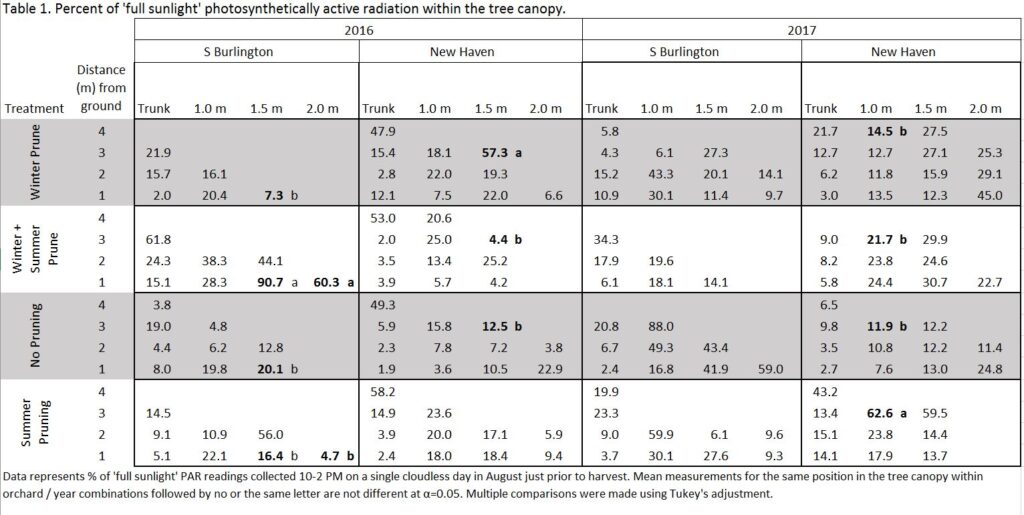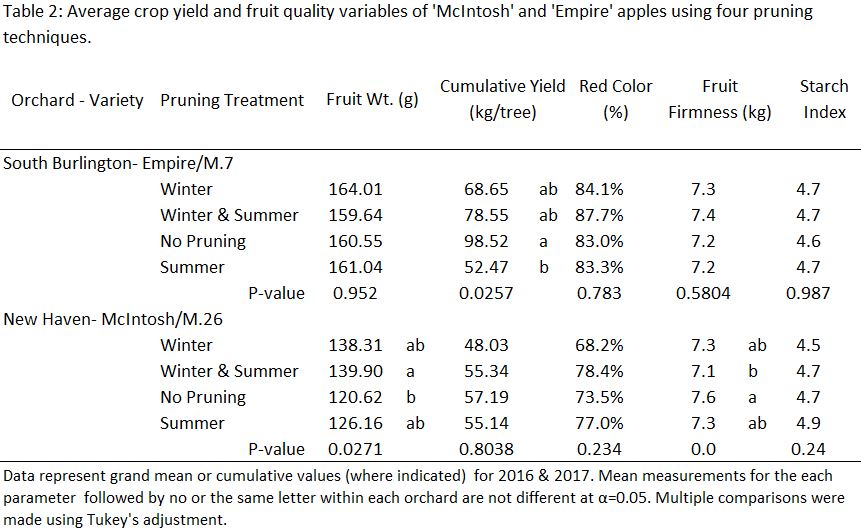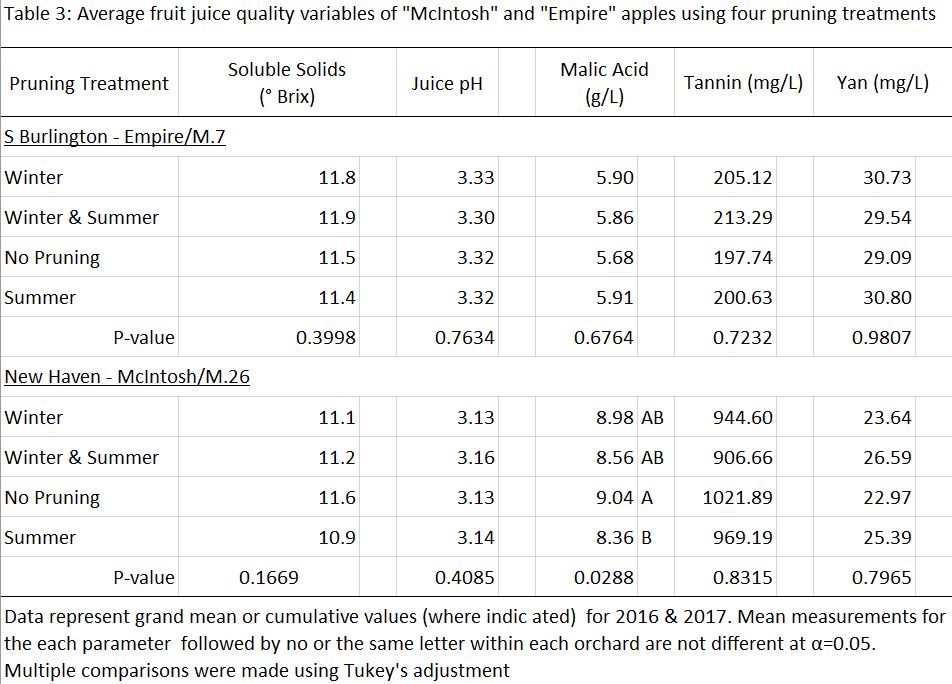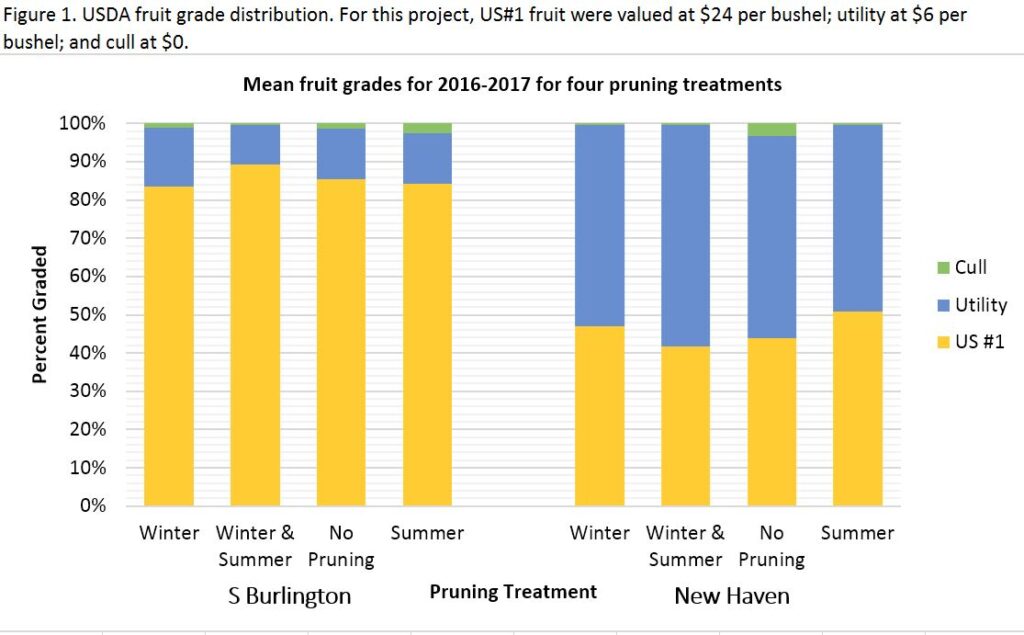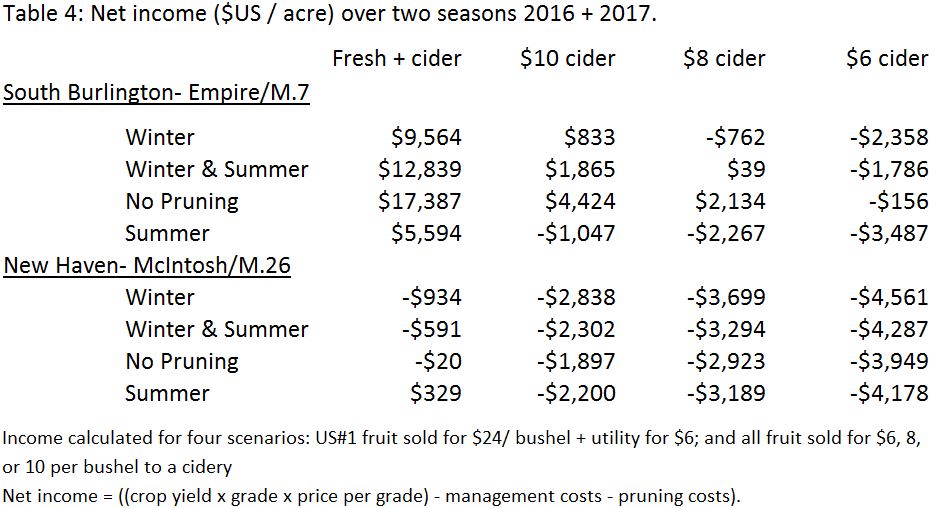Final report for ONE16-254
Project Information
Hard cider production increased dramatically in the U.S. with an annualized growth rate of 50% between 2009 and 2014 and revenues totaling $292.5 million in 2014. In Vermont, orchards are being managed specifically to provide fruit to this expanding market, but prices paid for processing fruit remain below those for fresh market apples. In order to meet demands for fruit supply at lower price points, growers must adapt management to reduce inputs and labor without compromising crop yield or quality.
This project evaluated reduced-labor practices that may improve profitability of cider apple production in Vermont. In two Vermont orchards, mature ‘McIntosh’ or ‘Empire’ trees will receive four pruning treatments: (1) ‘commercial’ dormant pruning with no summer pruning; (2) commercial pruning followed by summer pruning; (3) ‘light’ dormant pruning with no summer pruning; and (4) light pruning followed by summer pruning. Standard measurements for labor hours, sunlight interception, crop yield, and juice quality will be collected and analyzed to determine potential profitability of each system.
Overall, there were few effects within each orchard of reduced pruning on crop yield, fruit quality, or fruit grade. However, while not statistically valid because the design of the experiment did not randomize at the farm-level, there was substantial difference in fruit grade and subsequent profitability per acre (mean $45,673 vs $16,898 across treatments for the best marketing models) between the two orchards. This was attributable to fundamental differences in management between the orchards: one was owned / managed as a cider orchard by a cidery that sought to produce low-cost fruit, whereas the other was managed for higher-value fresh-market fruit. The cidery orchard, which yielded less and nearly always negative revenue per acre, was converted into higher-value cider by the operator which justified the business loss. On the other hand, a grower selling to a separate cidery would not recoup the lost revenue from making the cider themselves and thus would not be able to justify reduced input costs that were insufficient to compensate for 4x lower prices paid by cideries compared to fresh market retailers.
The objectives of this project were to:
a) evaluate reduced-pruning practices in older, traditional, dessert-cultivar orchards as a means to reduce labor costs and meet lower price points for cider apples;
b) evaluate impacts of reduced-pruning practices on juice quality for cider making, and;
c) conduct outreach on cider orchard management as a means to further extend limited personnel commitment to increase grower interaction with the UVM Apple Program.
Apple production in Vermont has been relatively stable at approximately 800,000 bushels and $10 million annual farmgate revenue since the late 1990s (NASS, 2014). While Vermont’s apple production ranked second among New England states over that period, its growers have received the lowest utilized price for bushel of fruit among the New England states. Hard cider (hereafter referred to as ‘cider’, as opposed to non-fermented apple extracts hereafter referred to as ‘juice’) production has increased dramatically in the U.S. in recent years with average annual growth over 50% between 2009 and 2014 and revenues totaling $292.5 million (Petrillo, 2014). Sixteen Vermont hard cider producers (hereafter referred to as ‘cideries’) purchased over 200,000 bushels of local fruit in 2014 at an average price of $5.75 per bushel, which is only 30% of the price received for fresh market apples (Becot et al., 2016; NASS, 2014). Expansion of the cider industry represents a significant opportunity for Vermont apple growers, but production methods which reduce costs to meet price points must be adopted to ensure profitability. Because cideries have greater tolerance for small, blemished, or poorly-colored fruit, reduced-intensity management practices may produce acceptable quantities of fruit with desired quality (hereafter referred to as ‘cider apple’) to be profitable for the grower.
Pruning and tree training are annual tasks performed in orchards to manage tree form, improve pest management, increase fruit size, and enhance red color (Ferree and Schupp, 2003). Pruning accounts for approximately 25% of labor costs in moderately high-density production systems in which trees are intensively pruned every year to optimize fruit quality (Quamme et al., 1996). Reduced pruning intensity in orchards managed for cider apple production may improve overall orchard profitability, but reduced crop production or quality below standards required by cideries as a result of changes in pruning practices could make cider apple production unprofitable for growers who typically sell apples to the fresh market.
Becot, F.A., Bradshaw, T.L., and Conner, D.S. (2016). Apple Market Optimization and Expansion through Value-Added Hard Cider Production HortTechnology 26, 220-229.
Ferree, D., and Schupp, J. (2003). Pruning and Training Physiology. In Apples: Botany, Production, and Uses, D. Ferree, and I. Warrington, eds. (Cambridge, MA: CABI), pp. 319-344.
NASS (2014). New England Fruits and Vegetables 2013 Crop, G.R. Keough, ed. (Concord, NH: New England Agricultural Statistics ).
Petrillo, N. (2014). Cider Production in the US. In IBISWorld Industry Report, IBISWorld, ed. (Melbourne, Australia: IBISWorld).
Quamme, H., Brownlee, R., Kappel, F., Geldart, G., Sanders, M., Arndt, H., Watson, T., and Waterman, P. (1996). Evaluation of five apple training systems in the Okanagan Valley of British Columbia. Acta Hort 451, 495-504.
Cooperators
Research
Project work was conducted in two orchards in Addison and Chittenden Counties, VT during the 2016 and 2017 growing seasons. Treatments were applied to established ‘McIntosh’ trees on M.26 rootstock (Happy Valley Orchard in New Haven, Vermont) or ‘Empire’ trees on M.7 rootstock (South UVM Orchards in Burlington, Vermont) and trained to a freestanding central leader system. Treatments included: (1) ‘commercial’ dormant pruning (standard pruning intensity used in commercial production (Bound and Summers, 2001)) with no summer pruning; (2) commercial pruning followed by summer pruning; (3) ‘light’ dormant pruning with no summer pruning; and (4) light pruning followed by summer pruning.
Commercial dormant pruning was performed following standard orchard practice. The goals of pruning included: 1) select semi-permanent scaffold limbs which support 2-5 year-old pruning wood; 2) select for wide branch angles that reduce limb breakage; 3) select for appropriate limb placement to improve light and spray penetration and to facilitate harvest; and 4) remove broken or diseased wood. Dormant pruning, when performed annually, may involve removal of 15-30% of the tree canopy, and typically is the primary method and timing of pruning performed on apple trees planted in a freestanding central leader system. Generally, horizontal scaffold limbs are selected such that they do not directly shade the ones below them, and to provide a 'Christmas tree' shape with branches spaced as whorls around a central trunk (leader) (Clements and Costante, 1992). 'Light' pruning in this experiment consisted only of removing diseased or broken branches.
Summer pruning is performed after the trees have set the terminal buds on one-year shoots, which typically occurs in mid-late July. This prevents trees from regrowing new shoots at the sites of pruning cuts which would be succulent going into winter and thus more prone to winter damage as well as aphid and fire blight infestation. Summer pruning is typically not performed to adjust tree structure, but rather to facilitate increased light and spray penetration into trees and to facilitate easier picking prior to harvest. In summer pruning, only a few minutes are typically spent per tree, and the pruner focuses on removing current-season vegetative growth, especially waterspouts, that shade ripening fruit within the tree. In most orchards, dormant pruning is practiced every year, and summer pruning as needed based on tree vigor or labor availability.
In the South Burlington orchard, the four pruning treatments were applied in a completely randomized design with six single-tree replications per treatment. The New Haven orchard was set up in a randomized complete block design, with six single-tree replications per treatment.
Each year, dormant pruning was performed mid-March, and summer pruning in early-August prior to harvest.
For each treatment-replicate, data was collected for: time to perform pruning, total crop yield (kg/tree) including dropped and harvested fruit, and photosynthetically active radiation (PAR) within the canopy following modified standard protocols (Hampson et al., 2002). Mean % full sun PAR was calculated for each pruning treatment within each orchard. Pruning time data for New Haven was collected by the grower participant’s workers, and was incomplete. Thus, pruning labor costs was extrapolated from limited data collected in the South Burlington orchard.
At harvest, a randomly selected sample of 25 fruit per treatment-replicate (tree) was collected and assessed for fruit size, color, general defects, and USDA grade distribution (Bradshaw et al., 2016). In addition, a sub-sample of ten fruit was selected for grading to be analyzed for juice quality parameters including pH, titratable acidity, total phenolics, and soluble solids using standard protocols (Miles and King, 2014). Where appropriate, data were and to analysis of variance (ANOVA) procedures separately by year and orchard site with pruning practice as the treatment (SAS Institute Inc., 2002-2010).
In addition, pruning was extrapolated to cost per acre and evaluated against potential orchard profitability per acre based on fruit grade distribution and published prices paid for fresh market and cider apples in Vermont (Becot et. al., 2018).
Becot, F. A., Bradshaw, T. L., & Conner, D. S. (2018). Growing apples for the cider industry in the U.S. Northern Climate of Vermont: Does the math add up? Acta Hort, In press. http://www.uvm.edu/~fruit/pubs/18Becot_ISHS_CiderAppleMarketVT_v3.2PrePub.pdf
Bound, S., and Summers, C. (2001). The Effect of Pruning Level and Timing on Fruit Quality in 'Red Fuji' Apple. Acta Horticulturae 557, 295-302.
Bradshaw, T., Parsons, R., Berkett, L., Darby, H., Moran, R., Garcia, E., Kingsley-Richards, S., Griffith, M., Bosworth, S., and Gorres, J. (2016). Long-term economic evaluation of five cultivars in two organic apple orchard systems in Vermont, USA, 2006-2013. Acta Hort 1137, 315-322.
Clements, Jon M., and Joseph F. Costante. (1992). "Effect of dormant pruning regimes on canopy light distribution, fruit and spur quality, and fruit packout of ‘McIntosh' apples." HortScience 27.6, 637-637.
Hampson, C.R., Quamme, H.A., and Brownlee, R.T. (2002). Canopy growth, yield, and fruit quality of 'Royal Gala' apple trees grown for eight years in five tree training systems. HortScience 37, 627-631.
Miles, C.A., and King, J. (2014). Yield, Labor, and Fruit and Juice Quality Characteristics of Machine and Hand-harvested ‘Brown Snout’ Specialty Cider Apple. HortTechnology 24, 519-526.
NASS (2014). Annual Bulletin, New England Agricultural Statistics, 2013, G.R. Keough, ed. (Concord, NH: New England Agricultural Statistics ), pp. 61-64.
SAS Institute Inc. (2002-2010). SAS 9.3 (Cary, NC).
Photosynthetically active radiation:
There were few differences in the percent of 'full sun' PAR in either orchard or either year, and what differences were seen were inconsistent across years and treatments. As was expected, PAR decreased lower in the tree and further into the center of the canopy, but all readings were below 75% PAR and most under 50% except for some readings in the highest sections of the tree canopy. After the second year without pruning, the greater concern was that canopies were getting difficult to manage for spraying and picking because of the excessive growth in many trees.
Crop yield & fruit quality:
For the South Burlington orchard, which has traditionally been managed as a fresh-market orchard with intensive pruning and other inputs, the No Pruning treatment yielded more crop per tree than the Summer Pruning treatment. We surmise that this is because those relatively well-pruned trees responded to increased fruiting canopy as a result of cessation of pruning, but it is possible that continued lack of pruning would compromise the quantity of the crop in future years. On the contrary, the New Haven orchard has been minimally-managed for a number of years, and therefore the Winter and Summer Pruning treatment likely led to greater light penetration (which is backed by the values shown in Table 1) that led to greater fruit size compared to the No Pruning treatment in that particular orchard. The only other statistically significant difference in fruit quality measurements was a practically irrelevant increase in flesh firmness in the Winter and Summer Pruned trees compared to the Non-Pruned trees, likely as a result of a subtle increase in ripeness attributable to increased light interception in the pruned trees.
Juice quality:
Juice quality parameters considered important for cider making were largely not affected by pruning treatment. Where a difference was observed among the New Haven treatments, reduced acid on Summer Pruned trees is a logical effect of improved light interception compared to non-pruned trees. However, the scale of the difference observed is of no consequence to cidermakers as all treatments in both orchards were within normal range for the cultivars. For most 'McIntosh'-type dessert apple cultivars grown in Vermont, a typical juice range of 10.5 - 12.5 ° brix, 3.1-3.3 pH, 5.0 - 9.0 g/l malic acid, and 200-1000 ppm tannins is common (Bradshaw et. al., 2018, Proulx and Nichols, 2003). Yeast assimilable nitrogen (YAN) is a component of juice which is required for yeast cell multiplication. There is currently no accepted threshold for acceptable YAN levels in cider for optimum fermentation, but recommendations for winemaking range from 140 - 350 ppm (Peck et. al., 2016). However, addition of yeast nutrients, which supply YAN and other compounds necessary for healthy fermentation, is a standard practice in the cider industry.
Fruit grade:
There was no difference among treatments in the separation of fruit into commercial USDA categories based on fruit weight, color, or defect ratings, and fruit were evaluated within each respective orchard (Figure 1). The orchards, however, had different ranges for fruit grades, with the South Burlington orchard producing 84-89% high-valued US#1 grade fruit, and the New Haven orchard only 41-52% in that category. We see greater fruit size and red color for the South Burlington trees in Table 2, and incidence of disease was greater in the New Haven orchard because pesticide inputs were minimized in that cider orchard (data not shown).
Economics:
Cumulative net cash income was modeled for each orchard and treatment (Table 4). Overall, the effect of pruning treatment was less of a factor in profitability than the proportion of fruit sold to higher-value fresh fruit markets. This is consistent with previous research (Becot et.al., 2016, Becot et.al., 2018) and explains why growers are reluctant to shift management even of fully amortized, established orchards over to a cider production model.
Bradshaw, T. L., Kingsley-Richards, S. L., & Foster, J. A. (2018). Apple Cultivar Evaluations for Cider Making in Vermont, U.S.A. Acta Hort, In press.
Becot, F. A., Bradshaw, T. L., & Conner, D. S. (2018). Growing apples for the cider industry in the U.S. Northern Climate of Vermont: Does the math add up? Acta Hort, Accepted Nov 2016.
Becot, F. A., Bradshaw, T. L., & Conner, D. S. (2016). Apple Market Optimization and Expansion through Value-Added Hard Cider Production HortTechnology, 26(2), 220-229.
Peck, G., McGuire, M., Boudreau, T. and Stewart, A. 2016. Crop load density affects ‘York’ apple juice and hard cider quality. HortScience 51(9):1098-1102.
Proulx, A. and Nichols, L. 2003. Cider: Making, using & enjoying sweet & hard cider. Storey Publishing, North Adams, MA.
The importance of reducing costs of production in any farming system cannot be overstated, and this project was initiated by a commercial grower who was interested in exploring cost savings to meet lower prices paid for apples by a commercial cidery. However, management of the orchard at which the research question originated changed prior to project commencement, and the orchard partner was content to produce low-cost fruit for his cidery business partners because the costs and returns were intermission between the businesses and thus were insulated from typical market situation. There were few differences in yield, fruit, or juice quality attributable to pruning intensity, but there was a slight trend observed toward more fruit on Non-Pruned trees in the well-managed orchard. Conversely, in the minimally-managed cider orchard, the trend leaned toward improved fruit quality in trees that were more heavily pruned compared to their default state.
Education & outreach activities and participation summary
Participation summary:
- Final project results have been submitted for presentation at XXX International Horticultural Congress, Symposium 9- Evaluation of Cultivars, Rootstocks and Management Systems for Sustainable Production of Deciduous Fruit Crops. Aug 12-16, 2018, Istanbul, Turkey. Conference paper will be published in Acta Horticulturae conference journal and linked back to this report upon publication.
- 20 specific one-on-one consultations (phone, email, site visits)
- Stakeholder meetings and tours convened at which project was discussed/presented
- Hard Cider Session (Seven speakers, 2.5 hrs), New England Vegetable and Fruit Meetings. 12/13/2017. Organizer and convener. Manchester, NH. 85 attendees.
- UVM Fruit Program Open House. Horticulture Research & Education Center, S. Burlington, VT. 8/25/2017. 40 attendees.
- Cornell University Program Working Team Champlain Valley Orchard Tour, Granville, NY to Burlington, VT. 8/1/2017. 32 attendees.
- 1st International Symposium on Beverage Crops. International Society for Horticultural Science. Cairns, AU. 11/25/2016. 17 attendees, primarily academics.
- Cider Apple Production in Vermont: Field Research and Cider Quality. 6/28/2016. Middlebury, VT. 45 attendees.
- Project-specific presentations at regional and national meetings
- Constraints & Opportunities for Selling Apples to the Cider Market. UVM Apple Program & VT Tree Fruit Growers Assn 122nd Annual Meeting. Middlebury, VT. 2/15/2018. 65 attendees.
- Constraints & Opportunities for Selling Apples to the Cider Market. 2017 New England Vegetable & Fruit Conference. Manchester, NH. 12/13/2017. 85 attendees.
- Recap of the 2016 Vermont Apple Season. UVM Apple Program & VT Tree Fruit Growers Assn 121st Annual Meeting. Middlebury, VT. 2/16/2017. 65 attendees.
- Cost of Production of Cider Apples. Oral presentation. 2017 U.S. Association of Cider Makers Conference. Chicago, IL. 2/9/2017. 120 attendees.
- Reduced Pruning Inputs for Dessert Apples grown for Cider Making. Advanced Cider Orchard Production Workshop. 2017 U.S. Association of Cider Makers Conference. Chicago, IL. 2/9/2017. 120 attendees.
Sample presentation: http://www.uvm.edu/~fruit/treefruit/tf_meetings/CiderVTFGA18.pdf
Learning Outcomes
In total, 270 farmers were in attendance at project outreach events where results were shared in detail, e.g. with complete data analysis and results/discussion. In total, 20% of attendees (54 farmers) completed surveys at the end of events. Overall, 23% of respondents reported that they managed some sections of their orchards separately and distinctly to grow apple for sale to cideries (as opposed to managing for fresh market apples and selling second-quality fruit to cideries). However, specific management practices used that differed between cider and fresh fruit orchards were not elaborated in the survey. In a separate, contemporaneous survey of a similar population of growers, 40% of growers reported reducing pesticide inputs in cider-managed orchard blocks, which suggests that this is a key practice used to manage cider orchards differently from fresh market ones. However, reduced pest management sprays and reduced pruning practices are not mutually exclusive, so some growers may use both strategies in cider orchards.
Project Outcomes
Impacts
Growers reported that after attending project workshops, only 9% would change pruning practices in cider orchards. We do not consider this relatively low rate of adoption of new practices a failing of the project. Because the results from economic analysis of project data suggest that pruning may be a relatively low cost activity in cider orchards, then saving on that essential practice which has been ingrained into standard orchard management practices will be difficult to change unless there is great economic benefit in doing so. The difference in managing a block of apples for higher-valued fresh market sales and selling only a small portion of second-quality fruit to cideries compared to selling increased quantities (up to the whole crop) to cideries was substantial enough that growers' interest in specifically growing traditional dessert cultivars (e.g., 'Empire' and 'McIntosh') as cider fruit appears to be declining.
This project approach could have been improved by selecting either more similar orchards for replication, or increased replication of default cider vs. fresh market-managed orchards. Data collection for pruning time was inconsistent between UVM program staff and the commercial partner, so increased coordination between the parties would improve that aspect but may not have affected the overall conclusions made. Increased study is warranted particularly on the specific cider apple cultivars that are grown only for cider making, have higher inherent value as cider fruit than dessert cultivars, and in modern and developing tree training systems that are being applied to cider apple cultivar orchards. Some of that work will be continued under a complementary grant received by the PI of this project: "Rootstock and tree training systems for unique apple production systems". Vermont Agriculture Experiment Station Hatch Grants Program, Oct 2017-Sep 2020. $64,084. PI: T. Bradshaw.
